SCOTT C. CUTTER -- Oswego, Illinois' favorite son designs a tree insulator!
by Carol McDougald
Reprinted from "Crown Jewels of the Wire", September 2002, page 24
You can almost imagine the 1904 headlines in the local paper of this rural
Illinois town, Oswego, located about 60 miles southwest of Chicago. Scott Cutter
was about to hit it big with his patent for an insulator designed to allow
installation using the trunks of trees.
In November of 2000, I placed a porcelain tree insulator made by Cutter in an
auction on eBay. To my surprise, it was purchased by Stephenie Todd who is
associated with the Oswegoland Heritage Association in Oswego, Illinois. Seems
that it wasn't the insulator she was after when she placed her bid, but
something attributed to one of that town's "favorite sons". The
porcelain insulator pictured at the bottom of page 36 with "OSWEGO,
ILLINOIS" in its embossing was the auction's description key to Stephenie's
purchase.
My communications with Stephenie following the delivery of the
insulator centered around trying to dig up more information on the Cutter family
and their descendents. I enclosed along with the insulator won a photocopy of an
original 1935 postmarked envelope from Scott C. Cutter addressed to B.J. Strumm,
Gen. Agt. of Aurora, Illinois which I had in my files. Stephenie was pleased to add this to their history on Cutter. She indicated that family descendants
has promised material, but to date she had not received anything from them. That
nearly two years ago, and sad to say, there still has not been any information.
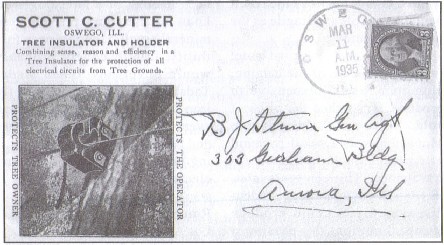
However, since that initial reawakening of the Cutter story, I have had several
opportunities to put together some more material regarding development of this
unusual insulator.
While digitizing old Crown Jewels of the Wire articles for
placement at www.crownjewelsofthewire.com. I ran across a Scott C. Cutter
letterhead in the May 1970 issue, page 22.
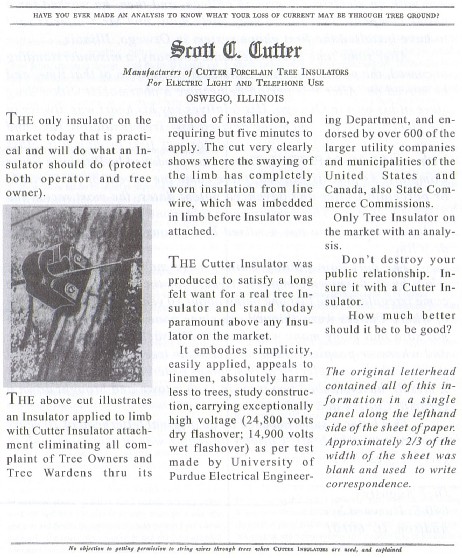
The following letter was written (using the Cutter letterhead) to Crown
Jewels of the Wire by Dick Augustyn which shares historical facts by Scott C.
Cutter's daughter:
Dear Crown Jewels,
As I knew the town of Oswego, Illinois, was not too distant from me, I
decided to visit there and learn what I could about the Scott Tree Insulator.
After a few inquiries about town, I learned that Mr. Scott C. Cutter passed away
in 1950. His beginning in this field was with an electrical degree in college,
and then he worked for a phone company. These were very early days, and Mr.
Cutter is said to have installed the first phone system in Oswego, Illinois.
After-some time in the telephone company, a misunderstanding occurred, the phone
company claimed his invention of that time, and he moved on. After this period
he became a pharmacist with a drug store of his own in Oswego. His relatives say
his heart was always in the electrical field. And so he devised his Tree
Insulator. Time and dates are unsure but the Tree Insulator was first produced
in glass with an APR 26, 04 PATENT. These were produced by Pittsburg Glass
Company. As patents expired, there came the advent of the ceramic or porcelain
Cutter and advanced patent dates, the most recent the JULY 23, 29 date. This
variety has a telephone wire application, and a slightly larger one has a raised
bead along the side for a water drip line.
The porcelain pottery Cutters were
made in East Liverpool, Ohio, by an unknown company. Orders for the ceramic
Cutter have come irregularly, the last one being about 10 years ago. Many
records of where Cutters were shipped are since gone, but Mr. Cutter's son has
said that many many went East to Massachusetts and New York and wherever people
wanted to save their trees. Most villages and towns with private electrical
companies ordered the Tree Insulators. I, myself, have climbed two trees in such
a town and brought down 6 ceramic Cutters and 2 glass.
This letter is
superimposed on an original letterhead of 20 years or more ago, which Mr. Cutter's daughter was gracious enough to give me, besides her time.
Dick Augustyn
640 S. Harvard Ave.
Addison, IL 60101
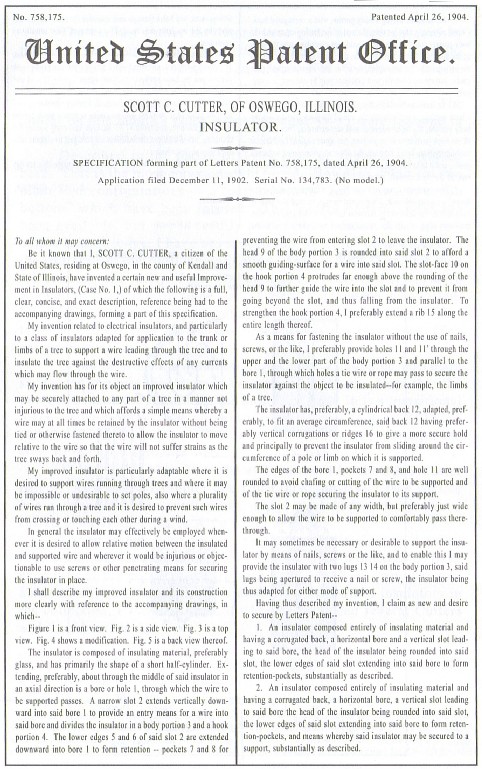
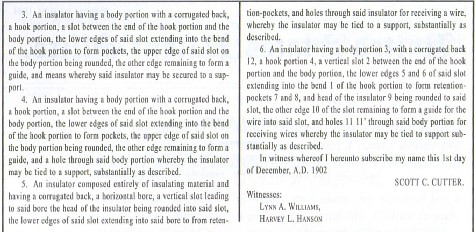
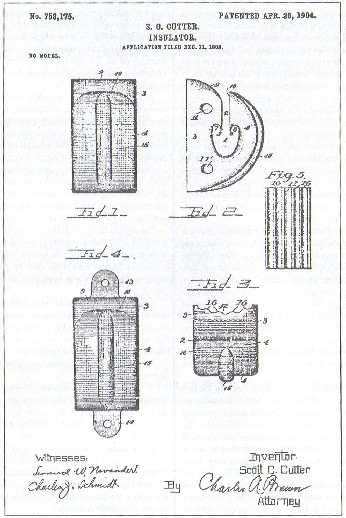
The earliest Cutter insulators were glass and are covered by the April 26,
1904 patent. At the September 2001 Enchantment Insulator Club show held in
Albuquerque, NM, Butch and Eloise Haltman of Cathedral City, California put
together several displays, one of which contained 14 different glass Cutter tree
insulators. The photos on this month's color insert on pages 33-35 were featured
in their display and are part of their collection.
Described in the patent of
1904 is a "corrugated" or ribbed base. That is the most common style
found. However, there are two other base configurations --- a "coffin
bottom" and a "reverse coffin bottom" which have been located.
The "coffin bottom" style has been available, but not as readily as
the ribbed base. And, to this author's knowledge, I have never seen the
"reverse" style except on the example in the Haltman collection.
Others may exist, but they are certainly the rarity. I am sure both of the
latter two styles were adapted to be used with some sort of metal bracket for
installation. Never, to my knowledge, has there been an example of a Cutter
insulator with glass lugs on the base for installation recovered. (See patent,
Fig. 4)
In the information obtained from Cutter's daughter, porcelain succeeded
the tree insulators manufactured in glass. Note that the porcelain insulator
pictured at the bottom of page 36 is a transitional piece between glass and
porcelain production. It has "PATENT PENDING" embossed on one side and
is more in keeping with the style of the glass units.
At the top of page 36 is
the style covered by the 1929 Cutter patent. As Cutter's daughter described this
later style: This variety has a telephone wire application, and a slightly
larger one has a raised bead along the side for a water drip line.
Trying to put
some lineage on the porcelain Cutters, I asked fellow Chicago land collector,
Rick Soller, if he happened to have examples of the porcelain styles with
brackets. Rick (who has just about everything "strange or different"
with regard to insulators in his collection, I wasn't surprised when he produced
several Cutters and their brackets.
Scott C. Cutter was issued Patent No. 1,620,804 on March 15, 1927. (Patent
drawing on page 31.)


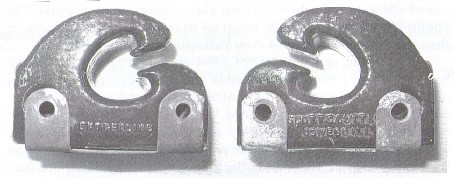
Pictured above you will see what I feel is an example of the design for the
insulator and bracket being covered in the March 15, 1927 Cutter patent. This
one being manufactured before the patent was granted (PATENT PENDING). One can
read into the patent description that problems of tree girdling had occurred and
Cutter wanted his insulator to have the capabilities of multipurpose installation
-- hence, the
introduction of a bracket.
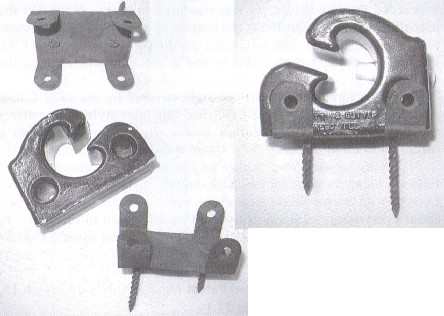
Rick Soller also had another example of a Cutter style with a taller profile (probably a
newer/improved style) that had its original bracket. This piece is embossed with only SCOTT C.
CUTTER / OSWEGO, ILL.
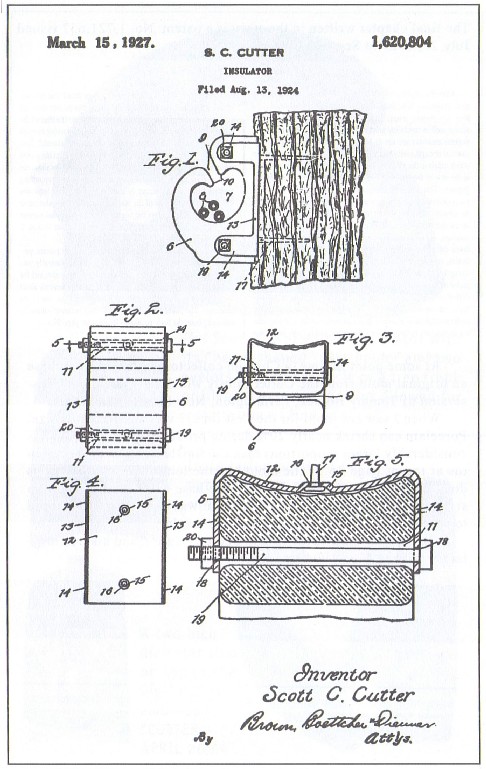
The final chapter written in the story is a patent No.1,721,657 issued July
23, 1929 to Scott C. Cutter.
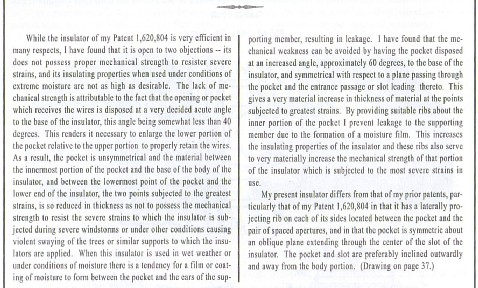
At some point in time, a Chicago collector was able to purchase an original
mold from the Cutter family which now is a prized possession of Tommy Bolack,
Farmington, New Mexico.
When I saw the mold for the first time, I was amazed at
its size. Porcelain can shrink nearly 20% during production, so the mold has
considerably larger proportions than the finished product. (See photos at top of
page 36.) The mold has the letter "T" on its side, as does the
finished example shown. The base has a "coffin" bottom style, which
according to the 1929 patent was a recess manufactured to specifically lighten
the weight of the insulator.
Oswego, Illinois' favorite son, Scott C. Cutter,
and his tree insulators reigned from 1904 into the 1950's.
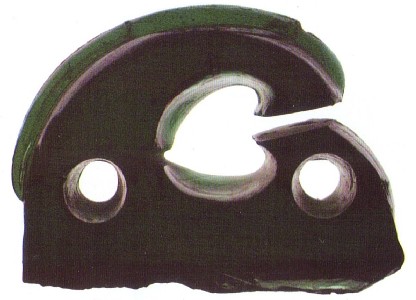
The Scott C. Cutter tree insulator with its "heart-shaped" wire
holder and two eyelets used to secure it to a tree trunk or limb. A narrow nose
slot allowed for installation of line wire.
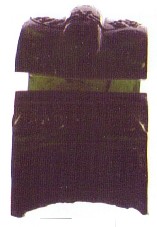
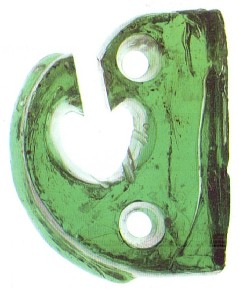
Installation position -- note the wear of Line wire in the slot.
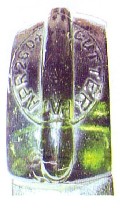
A two inch diameter slug on top of the
insulator is embossed "CUTTER
APRIL 26,04".
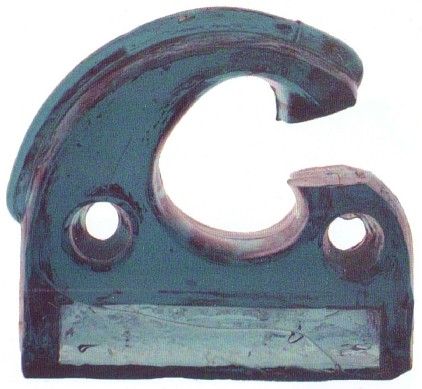
The Cutter insulator is found with three different base configurations. This
is the "coffin bottom" which has a rectangular depression in the base.
It also has an extremely tall profile for this base style.
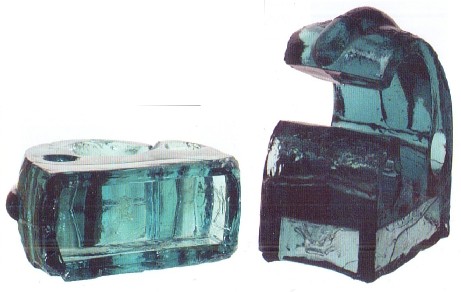
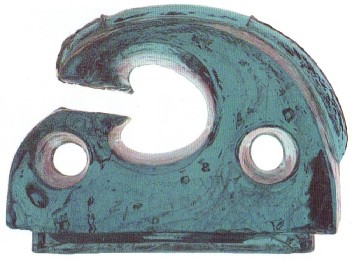
There is also a ra re "reverse coffi n bottom" which has a solid
recta ng u la r base extension.

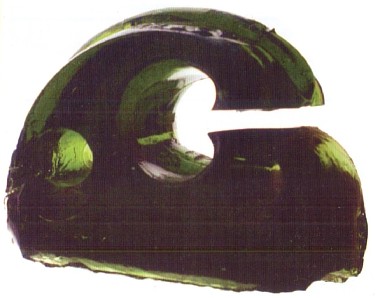
The ribbed base is the most commonly found base configuration for the CD
1038.
Most Cutters are found in shades of aqua glass, with a small percentage
available in green and olive green.
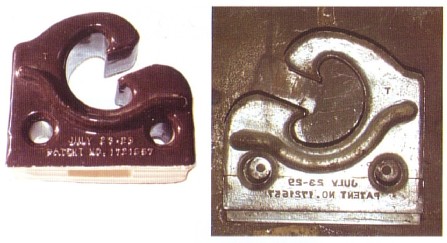
The Cutter tree insulator was also manufactured in porcelain: A mold for the
porcelain style (owned by Tommy Bolack of Farmington, New Mexico) is much larger
than the finished product. There is almost a 20% shrinkage in porcelain during
the firing process.
There are two base styles in porcelain cutters, a
"coffin bottom" and a ribbed style.
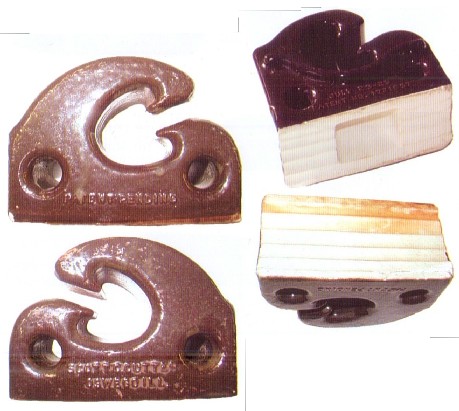
Earlier units are marked PATENT PENDING
and SCOTT C. CUTTER/OSWEGO, ILL.
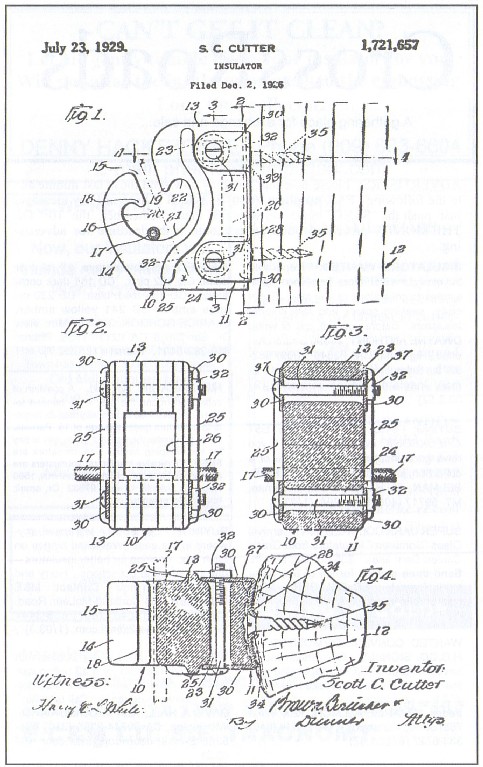
| 